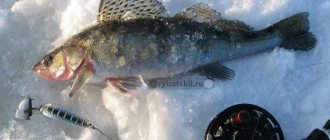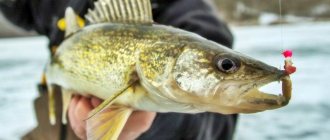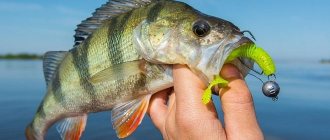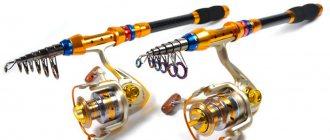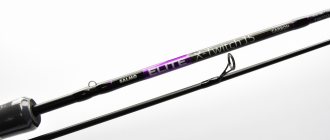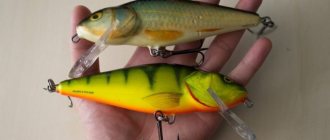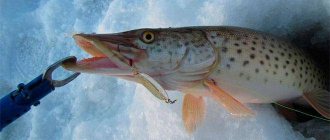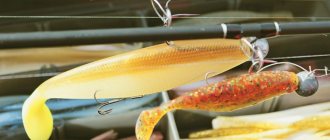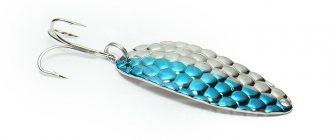Silicone baits for pike perch no longer surprise our domestic fisherman with their variety of shapes, colors and even tastes. Today, bait of this type is more of a mandatory attribute of spinning fishing than a curiosity and a scarce product, as it was a couple of decades ago. The low cost of silicone and the realistic way it conveys the movements of a fry or other natural food item of a predator have brought simulators to the leading position of use, and fishing for pike perch with an elastic band has become the most popular method of hunting.
The huge selection of products also entails a number of difficulties in selecting the most effective baits for certain fishing conditions and the mood of the pike perch. After all, as often happens, there is practically no place for versatility in fishing, and this statement is directly related to the selection of silicone that is promising for catching fanged fish.
The purpose of the article is to acquaint the reader with the varieties of pike perch silicone baits that can increase the number of effective bites, as well as for the spinning angler to understand the methods of forming a spinning rig. In addition, we will present a rating of the most popular and effective silicones in practice, from which you can form your initial pikeperch arsenal.
Types of silicones for pike perch
Let's start our conversation by considering the types of artificial baits that are acceptable in spinning pike perch fishing. Specific rubber for pike perch has a number of features from pike and perch baits, which is worth paying attention to when purchasing a product. Due to its physiological characteristics, the fanged one feeds on small fish with a thin body.
Most often, its victims are bleak, dace and small roach. This is due to the narrow mouth of the predator, which is unable to swallow large fish. Therefore, the shape and size of silicone baits in appearance and type should resemble the real size of the object of his hunt. Otherwise, almost all types of silicone are suitable for pike perch fishing, which today can be easily purchased in fishing stores at a reasonable price and in unlimited quantities.
Vibrator tails for pike perch
The vibrating tail for pike perch looks and works identically to the classic vibrating tail for pike fishing. The only difference is in size and shape, which the reader will learn more about in the continuation of the article. This type of rubber resembles a fish with a small tail, which is attached to a more massive body on a thin leg. The tail itself, in its shape, resembles a horse’s hoof and is often called a hoof in spinning slang. The tail is flattened in its upper part and it is this that serves as the main working element of the bait.
When retrieving, the swaying movements of the tail, provoked by a thin leg, create longitudinal vibrations, which, quickly spreading in the water, attract fish. Some varieties of vibrating tail have notches and corrugations on their body, in addition to longitudinal vibrations, creating a noise effect. This feature helps attract passive fish to the silicone.
Twister
Twisters and vibrotails are the most common types of rubber when fishing for pike perch, but few novice fishermen understand their differences, much less the principles of their operation. In addition to the main and immediately noticeable visual difference of the tail of the nozzle, twisters have a torpedo-shaped body covered with ribs along the entire length of its circumference.
The twister tail, as in the case of the vibrating tail, performs the functions of the main working element. It has a crescent-shaped shape, sometimes twisted into a spiral, and a flat structure; it is distinguished by its ability to play independently when guiding and diving into the depths. In some modifications of twisters, the tail is 1.5-2 times longer than the body. Wave vibrations of water and noise effects are created by the ribs of the nozzle. Compared to a vibrating tail, twisters produce high-frequency radial vibrations.
Others
During periods of unstable bite and low activity of pike perch, spinning anglers experiment with feeding fancy forms of silicone and slugs, which can often radically change the pattern of unsuccessful fishing. A catchy silicone bait for pike perch can easily be a well-sized ribbed worm or a tempting-looking creature. In nature, pike perch is not averse to feasting on crustaceans that come within its visibility zone, which in spinning fishing can be imitated by silicone, similar in shape and appearance to crayfish or another fancy form with claws and movable legs protruding to the sides, creating a wave and vibration background attractive to the predator .
Lures of unconventional types add variety to fishing and increase the chances of success, so having a couple or three of these kinds of exotics in your arsenal will certainly not be superfluous for a zander.
Features of twisters for catching pike perch
Pike perch often have to be caught in snags with a hard rocky bottom. In such conditions, there is a high risk of damaging the bait and leaving it on the bottom, especially when using a drag along the bottom. Taking this into account, twisters for pike perch are not very soft, but at the same time they should show a meaningful game, to which a predator with the habits of an aristocrat would react positively.
It’s another matter when we fish shallow, for example, at night in the summer. In this case, it is better to use soft baits with active play. At night, they will clearly identify themselves and the pike perch will naturally “appreciate” their behavior.
The size of twisters for catching pike perch is 5-9 cm. This is the standard from which you need to build. In any case, spinning anglers start fishing with twisters of this length. In the summer they use shorter twisters, and in the fall they fish with larger ones. In general, once again it must be said that autumn is considered the most fruitful time for catching pike perch. All an angler needs to do is take proven twister models, find a hole or a steep edge and methodically jig places with pike perch.
Another important parameter when fishing for pike perch is the weight of the bait. As a rule, jig heads weighing from 15 to 50 grams are used. Every fisherman has a set of sinkers. Therefore, when fishing there are no problems with selecting the right sinker. When fishing is carried out in a quiet place and in shallow water, relatively light weights weighing from 10 to 20 grams are used. When fishing in the current, you may need sinkers weighing 30-50 grams.
When fishing for pike perch, three rigs are most often used. The first - with a weight soldered into the hook; the second - with a weight attached to a clasp. These two methods look like this:
The third installation is with a diverter leash:
We see that the weight is dragging along the bottom, and the twister is moving above it. This method is good in cases where you have to fish on a snag or rocky bottom. By making a slow retrieve in this way, you can lure pike perch, which likes to hide behind rocks or snags.
Another important point is the smell of twisters for catching pike perch. To understand which scent is suitable for catching pike perch, you need to experiment. You shouldn’t start from scratch; it’s better to purchase several types of edible rubber with different, but pike-perch smells, as well as 4-5 types of sprays and odorless silicone from a fishing store. You can start fishing with flavored twisters. They usually smell like fish, shrimp, worms, etc. If none of the options work, then we use sprays. We just spray the bait and fish with it for 20-30 minutes.
There are several features associated with fragrances. When we catch pike perch on a stream, we can use baits with stronger odors. In this case, they will work longer. When we fish in a quiet place, we use not very strong aromas. It is advisable to renew silicones with sprays every 15 minutes when fishing in a current and every 30 minutes when fishing in an area with a weak or no current.
Odors spread at different speeds in warm water and in cool water. This needs to be taken into account. In general, attractants work better in the summer. The pike perch is not so active at this time, and to attract it, you can play with scents. The trail from the bait will spread quite far. When we make several dozen trips, we will fill the area with aroma and it is quite possible that a school of pike perch will decide to stay longer in this place. You can catch such a good fish in a few hours that neighboring fishermen will be jealous. And the outcome of the fishing will be decided by just a small bottle of spray, which was selected from the same ones, only with different smells. These are the flavors for pike perch you can find in fishing stores:
In autumn, attractants spread more slowly, so you shouldn’t count on them too much. You can try bloodworm, shrimp and worm flavors.
As for the shape of twisters for catching pike perch, you can use both classic versions with a question mark and with a less expressive tail. When we drag the bait along the bottom, we can cut off the tail altogether or fish with a long silicone worm. In this case, the smell of the bait and, let’s say, its maximum naturalness during retrieval are important, so that it fits into the environment.
A very important point is the correct storage of twisters and other silicone baits. Under no circumstances should they be exposed to the sun. Direct sunlight can destroy soft silicone in just a few hours. Lures may turn to jelly. Silicones must be stored in a dark and cool place. You can use it in your nightstand at home. It is not suitable to store them on a windowsill or on a balcony on the sunny side. Place the smelling silicones in an airtight container. This way, odors will not disappear quickly.
A normal twister is slippery, like butter. It may also be a little sticky. If the twister has turned into only a semblance of itself, then the wiring will be only a semblance of fishing. It will be very difficult to catch pike perch with such bait.
As for the colors of twisters for pike perch, spinning anglers most often use twisters of marsh, green, purple, dark red and even black colors. Transparent twisters have proven themselves well. Many models have sparkles that create animation during wiring. These twisters are used to successfully catch pike perch at great depths.
Edible rubber for pike perch
Among spinning anglers, the use of edible rubber for pike perch is popular. This type of silicone does not differ from ordinary rubber in shape, size, or color, but it contains odorous attractants similar to the tastes of pike perch’s natural food items. The odors are not so pleasant to the fisherman and smell strongly of fish oil, but they are effective on the predator’s sense of smell. Lure manufacturers impregnate rubber with flavoring, offering products in sealed bags in which the bait can be stored for a long time without losing its attractive properties.
In practice, the use of edibles provides a number of advantages, and these advantages are associated not only with attracting fish to the fishing zone. An edible gum on a pike perch, once in its mouth during a successful attack, masks the natural smell of silicone, and the released aroma of a natural prey increases the time the predator holds the bait until the deception is recognized. The extra seconds give the angler additional opportunities to more reliably comb the bony mouth of the pike perch, and therefore increase the chance of ultimate success.
Let's talk about color
In the area of choosing the color of a silicone nozzle, there is still no consensus among pike spinners. One part of fishermen considers color design to be an important factor in the attractiveness of silicone for catching pike perch, while the other, on the contrary, does not see any difference in it. Manufacturers offer a wide range of product colors to the fishing markets, which can be quite difficult to decide on. From fishing practice, it is worth noting that if fishing is carried out at depths of more than five meters, then there really is practically no sense in the color design of the bait.
Important! At depths, the predator focuses on the vibrations and noise effects created by the rubber imitation.
The only exception is the presence in the body of material from fluorescent inclusions flickering at the bottom. But when fishing shallows up to 3-5 meters, pike perch is quite clear about colors, and this characteristic of the bait acquires its share of importance. In cloudy weather, it is recommended to use bright and light colors, acidic, carrot and yellow tones. When fishing in clear sunny weather, silicone is selected in natural dull colors, using dark blue and gray tones and the color of machine oil, attractive for pike perch hunting.
What shape should the bait be?
Pike perch is characterized by preying on small prey with a narrow body. He is able to quickly swallow such a fish with his mouth, which has a specific structure. The same selection principle applies to the rubber used for catching pike perch.
Important! Preference is given to flexible and narrow-bodied silicones, the length of which rarely exceeds 70 mm.
The thickness or diameter of promising nozzles is no more than 10–15 mm. You should not increase the size of the tires with the expectation of catching large and trophy fish. Even a five-kilogram pike perch may well become a victim of a three-centimeter bait. After all, the tactics of hunting for fanged fish involves starting fishing with a large bait and, in the absence of fish activity and uncertain bites, switching to using smaller baits. Slugs, creatures and fantasy forms are selected by analogy with vibrotails and twisters, in medium sizes, without massive plumage and a small span of legs or claws in relation to crustacean imitations and rubber resembling an insect or larva.
Advantages of silicone bait
What are the advantages of this silicone bait?
- the ability to set the desired game to the silicone bait, if the bait begins to play in the hands of the spinning rod, then this is a special game, different from other types of silicone;
- the ability to perform various types of wiring;
- good range;
- sinks well, which allows the spinner to catch a fishing spot faster, compared to other silicone baits, and also cope with strong currents, since the slug’s sinking speed will not have time to come under its influence;
- the bait is effective in warm water;
- performs well when fishing in snags and thickets, since due to its streamlined design it easily slips through such water obstacles;
- You can easily make a slug from any vibrotail and twister if the tails of these baits were bitten off when biting.
In overgrown areas of the reservoir, the slug imitates a fish well. It is known that fish move in water thanks to their pectoral fins, and the tail remains motionless. The fish begins to move its tail part only when escaping from a predator. The lack of a tail and behavior of the slug allows the fish to judge it as careless and careless prey, which is an excellent reason for swallowing the bait.
The lifestyle of marine fish of the Mediterranean Sea, their character, method of feeding, types of gear and bait suitable for catching wayward inhabitants, interesting videos and amazing facts, you will learn from this section
In this video, see how a slug behaves in water
Read about the lifestyle of freshwater inhabitants of Israeli reservoirs and revealing the secrets of catching them here
Top silicone baits for zander
Continuing the article, we offer the reader a rating of the best pike perch silicone baits, collected in the top 10 in terms of attractiveness and availability on our domestic market, which can give direction to the spinning angler for organizing an effective and working collection.
- The rightfully deserved first line of the top 10 belongs to the Lucky John and its model range of Tioga attachments, known to every pikeperch fisherman. The relatively low price, various sizes, ideally suited to fanged shapes and colors make the leader of the vibrotail rating a classic pike perch bait.
- Reins doesn't need too much introduction either. His zander model of the Bubbling Shad works great on jigging retrieves, and the Saturn slug is used in spaced rigs and, in particular, is a catcher in drop-shot rigs.
- Three for Pontoon21 and his pike perch brainchild in the form of the vibrotail Awaruna. Inexpensive edible silicone is characterized by increased strength, capable of withstanding more than one serious attack from a fanged one without losing its appearance.
- The rubber from Japanese Keitech , differs from similar products from other brands only in its higher price level. Otherwise, it has models that differ in the density of the material, its elasticity, and, consequently, the manner of play. Let's highlight such baits as the Easy Shiner, Swing Impact and Sexy Impact slugs.
- Prestigious five for Sawamura . Among the representatives of the baits of this Japanese brand, I would like to highlight such an option as the One'up Shad, called the zander killer among spinning anglers.
- On the sixth line is Bass Assassin Turbo Shads 4 . Its color diversity with the presence of fluorescent in its body facilitates fishing in areas of water bodies of different depths. In addition, edible rubber sets are quite comfortable for the angler at the price.
- Crazy Fisn Angy Spin 2 is a universal twister capable of bringing surprises in the form of catching trophy pike and perch when fishing for zander. Included in the rank of budget baits.
- Manns brand did not remain without attention to pike perch , releasing a specialized line of models under the abbreviation Predator. Having a set of such rubber in a spinning player’s arsenal allows you to feel more confident with passive fish, receiving long-awaited bites.
- Nine for often saving fantasies from the company Gary Yamamoto . In particular, the combination of twister and squid in the Hula Grub model does a decent job of luring sluggish pike perch to bite.
- Rounding out the top of the best vibrating tails for pike perch is the Relax Kopyto . The bites of a fanged fish on this rubber are not encouraging with its stability, but if the spinner feels a blow, then rest assured that this is a trophy specimen. The attachment is universal and works well on pike.
Attaching a silicone slug bait
Basic methods of installing a slug:
- drop shot;
- Carolina rig;
- diverter leash;
- jig head;
- hinged installation with a collapsible Cheburashka load;
- installation of veki.
Find out how to perform perfect and reliable installation of other silicone baits - here
Basic rules for attaching a slug:
- The silicone bait is attached in the area of the front part of the body, so that the tail element is in a free position;
- If the slug is attached to the offset fish hook, then the offset tip must be hidden in its body.
- To mount the slug, large fishing hooks are used, since its body is larger in size than an ordinary worm and for high-quality hooking it must be one third larger than the width of the body of the bait.
To learn how to choose the right hook, what characteristics of a hook you should pay attention to first, and how to choose a hook for specific fishing conditions, read useful tips
Installation of "Veki"
Of all the above installations, the most popular is the installation of a slug on an offset hook, since in such baits there is a slot along the back to hide the tip of an offset hook. Moreover, this type of fastening does not require additional loading. Of course, it is possible to mount it on an offset machine in tandem with a bullet load or a Cheburashka load. For example, in order to increase the game of the bait, you can fasten the slug on a retractable leash, which is tied to the leash not with a knot, but with a loop, so that the eye of the fishing hook with the slug behaves freely on this type of fastening (for example, you can use a loop "Rapala")
Montages
Slugs, twisters and vibrotails for pike perch are included in a variety of combinations of rigs used by spinning anglers for various fishing conditions. The main types of installation are combined, when the load and the rubber itself form a single bait unit, and spaced, in which case fishing for pike perch with silicone is carried out with a load removed from the bait at some distance. By the way, it is worth noting that these categories of installations do not differ from each other in success. With well-developed tactics taking into account the structural features of the reservoir, pike perch can be caught well with both types presented. The fisherman should have an understanding of the rationality of using this or that category and be able to correctly complete the installation, which you can learn about in the continuation of the article.
Combined
There are three main options for assembling combined rigs: on a combined jig head, with an eared sinker, better known as a Cheburashka, and a hinged jig rig. The classic and easiest to assemble jig head rig. A hook of different length and size in this combination is soldered into a spherical lead sinker, a jig head, which has a different weight. The rubber is threaded onto the hook so that its tip comes out on the back of the fish. When assembling a Cheburashka, a hook of the required size, separate from the load, is embedded in the silicone and only after that is connected to the sinker. The result is a movable hinge joint. The jig rig option is based on connecting a hook and a sinker through a common winding ring, to which the cord will subsequently be attached. To a greater extent, the category is suitable for catching pike perch using a vibrotail and twister, which have their own game.
Spaced
The category of spaced rigs involves the use of inert baits and floating rubber. The assembled structure looks bulky and requires certain skills in wiring techniques, but it is effective when hunting in places cramped with various obstacles.
The essence of the installation is based on the movement of the load in front of the bait at a certain distance, which is regulated by cutting the main cord or the leash included in the equipment. The shape of the load in such rigs also varies, ranging from the type of Tyrolean stick to a bullet and pear-shaped sinkers. The most popular options among pike-perch fishermen are such spaced-out mounting options as a branch leash or a Moscow rig and a drop-shot. From across the ocean, Texas and Carolina rigs migrated to us from bass fishing, which are also suitable for pike perch fishing under certain conditions.
Principles for choosing baits
Due to the fact that silicone for catching pike perch is an inexpensive but very effective type of bait , it is now presented in a very wide variety in retail outlets. Therefore, it is important for every fisherman to understand how to choose the best silicone baits for pike perch among all the proposed options.
The main parameters that distinguish one bait from another include:
- type of bait (shape);
- size;
- color.
Every pike perch hunter eventually develops the most favorite and most catchy silicone pike perch baits, which he then advises his friends to take. The catchability of one or another depends on the characteristics of the reservoir, weather conditions, the compatibility of all elements of the fisherman’s tackle and, of course, the spinning rod’s technique for guiding it.
As for the type of bait, it can be any of the above, but you should know that the best silicone baits for pike perch have a narrow, elongated body shape , the shape of the tail is secondary, but it should be small. And it is also important that the selected product has appropriate workmanship. It’s not for nothing that manufacturers produce so many types of it, differing from each other in certain nuances in shape, bends, etc.
The best silicone for pike perch always has all the shapes and proportions that were intended by the manufacturer. This allows the bait to work in full accordance with its intended purpose.
The size of this type of bait directly depends on the size of the intended prey; the larger it is, the more important a predator can be caught with it. But still, in the case of pike perch, this rule does not always work; of two different artificial baits of the same type, it is better to give preference to the one that is slightly smaller in size. Unlike, for example, pike or perch, the fanged one does not like to take very large bait. The animation it produces is much more important to him.
It is known that the vast majority of spinning anglers begin to choose silicone for pike perch based on its color. In fact, this factor is not paramount. On the same body of water on different days, pike perch can be caught with baits of completely different colors. The weather and wiring style play a big role in this case . Therefore, it is recommended to take baits of different colors with you when fishing, and during the fishing process, experimenting, select the most effective one.
Successful fishing for pike perch with silicone can be done with either green or brown, light green and even purple baits, but still, according to most fishermen, the most catchy silicone for pike perch has a bright red or natural color , close to the shades of the indigenous inhabitants of a given reservoir .
When choosing the color of a bait attached to a spinning rod, you can adhere to the principle: the cloudier the day, the brighter the shade it should have.
In any case, when going fishing for a fanged predator, you should take with you as many different options of silicone baits as possible.
How to catch pike perch with a rubber band
Catching pike perch with an elastic band is successful in river beds with moderate and strong currents, near depth changes and the presence of bottom anomalies, snags, driftwood, large stones and abandoned building structures. Often the fanged site can be found near hydraulic structures, bridge supports, dams and dams. The predator does not disdain depth and can live both at three-meter levels and at depths of 15–20 meters.
Having decided on the type, size and color of silicone for pike perch, select an installation category suitable for the structural conditions of the reservoir. They fish with spaced rigs in snags in water areas. Their cross-country ability and maneuverability are much higher than combined installations, and with a tight hook, only part of the equipment is lost. The nozzles in such rigs are carried on uniform lines, and its animation is carried out due to the flow of water. What makes the method attractive is the cloud of turbidity raised by the sinker dragging along the bottom. Combined rigs are used to fish on a relatively clean bottom, using classic step jigs or the stop-and-go technique, selecting the most effective time pauses for attacking fish.
Important! In pike perch fishing, it is important to knock the weight on the bottom, which additionally attracts the fanged fish to the trajectories of the silicone nozzles.
The best twisters for zander
- Bait Breath Fish Tail. This twister is not like its standard counterparts. He doesn't have a big tail. However, the swamp and green models have proven themselves very well when dragging along the bottom and in step retrieving. Pike perch attack them very actively.
- Mister Twister. The bait of the American manufacturer is effective for jigging and dragging along the bottom. It shows the best results when fishing in shallow and medium depths.
- Relax. This model has a pronounced ribbed surface and demonstrates a very original playing. This twister shows the best results when catching active pike perch.
